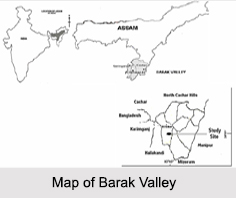 Located in the southern region of the eastern state of Assam, the Barak Valley is named after the Barak River, which is one of the inland waterways of India. The Valley mainly consist of 3 distinct administrative districts namely Cachar, Karimganj and Hailakandi and the main city of the Barak Valley is Silchar. The Barak Valley has two Lok Sabha seats; it is from the Karimganj and Silchar constituencies.
Located in the southern region of the eastern state of Assam, the Barak Valley is named after the Barak River, which is one of the inland waterways of India. The Valley mainly consist of 3 distinct administrative districts namely Cachar, Karimganj and Hailakandi and the main city of the Barak Valley is Silchar. The Barak Valley has two Lok Sabha seats; it is from the Karimganj and Silchar constituencies.
History of Barak Valley
Originally part of the Tripura kingdom, the Barak Valley has been annexed and its administrative head had changed over the centuries. First, in 1562, the Cachar region was annexed by Nara Narayan"s younger brother Bir Chilarai. The region was annexed to the Koch kingdom and was administered by Kamal Narayan, their half brother and after the demise of Nara Narayan, the Cachar region passed on to the Kachari kingdom. Later in the 18th century, the Kachari king also annexed the region of Hailakandi to the Kachari kingdom.
Later in the year 1832, during the time of the British colonialism, the kingdom of Kachari was annexed to British- India. The British Companies established a total number of 157 tea estates in the area and Silchar, headquarter of the district emerged as a very important centre in this part of the country.
More than a century later, during the time of the Indian Independence, a plebiscite was held in Sylhet, which later famously came to be known as the 1947 Sylhet referendum. Here, the district was divided in two and the eastern part of Sylhet which is known as Karimganj remained with India whereas the other part fell under East Pakistan.
Demography of Barak Valley
As per the reports of Census India 2011, the majority religion in the Barak Valley is Hinduism with about 50 percent of the total population. In the Cachar district, Hindus are in majority with a percentage of about 59.83 percent. The other religious compositions of the Valley consists of Muslims about 48 percent, Christians about 1.6 percent and the rest 0.2 percent. The districts of Hailakandi and Karimganj have the maximum number of Muslims with 60.31 percent and 56.26 percent respectively.
Wildlife Sanctuaries of Barak Valley
The Borail Wildlife Sanctuary is the only wildlife sanctuary of the Barak Valley region, which was initiated by noted naturalist Dr Anwaruddin Choudhury, who originally hailed from this region in the early 1980s. This sanctuary was ultimately notified in 2004. Other than this, Hailakandi have the Inner line reserve forest and Katakhal reserve forest. Barak Valley used to be the home of the Asian elephants but currently they are mostly endangered and cannot be found on the valley.
Visiting Information on Barak Valley
The Barak Valley is well connected via roadways, airways and railways and can be easily accessed. The Silchar railway station is the closest at a distance of 29 km and the Silchar Airport is the nearest at about 54 km away from the valley.



















